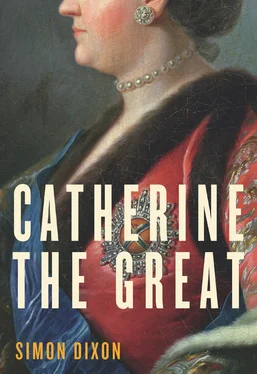I saw the clergy appear, then the candle-bearers, the choristers, and the Imperial family, and lastly the corpse, which was carried on a magnificent bier covered with the Imperial mantle, the ends of which were borne by persons holding the highest offices at Court. When I caught sight of my sovereign, I began to tremble all over and ceased to weep, while my sobs changed to involuntary little cries.
Six gentlemen of the bedchamber carried the train while ten chamberlains bore the corpse to a raised bed covered with red velvet fringed with gold. At the end of the ceremony, the whole imperial family ‘prostrated themselves in turn in front of the body and kissed the hand of her deceased Majesty’. Once they had withdrawn, a priest began to read from the Bible, while six Chevaliers Gardes formed a guard of honour around the bed. The countess returned home ‘after being in attendance twenty-four hours, exhausted both in mind and body’. 8
Ten days later, Catherine was laid to rest in a coffin done out in gold fabric decorated with Russian imperial crests and taken to a chamber of mourning in the palace’s Grand Gallery. Familiar to the Court as the site of its glittering balls and masquerades, the gallery had been transformed by the erection of an elaborate chamber of sorrows designed by Antonio Rinaldi. This dome-shaped structure, supported by classical pillars and topped by a bronze statue of the imperial eagle, enclosed the coffin on a raised platform beneath a canopy draped in black velvet with silver fringes. The corpse was dressed in a robe of silver brocade. A gold brocade mantle trimmed with ermine and silver tassels was placed at its feet. As leading courtiers stood in vigil over their late sovereign, and bishops and archimandrites chanted requiem services around the clock, only badly dressed peasants were refused admission to the lying-in-state as the public flocked in to pay their respects with a final kissing of hands. 9
Paul agreed to such pomp and ceremony only in order to undermine it by extraordinary means. Three days after his mother’s death, the tsar announced plans for a joint funeral at the Peter-Paul Cathedral, in which Peter III, rather than Catherine, was bound to be the focal point of attention. The point, he sardonically remarked, was merely to remedy her ‘oversight’ in failing to accord her husband a proper burial: ‘My mother, having been called to the throne by the voice of the people, was too busy to arrange for my father’s last rites.’ 10On 10 November, after paying their respects to Catherine’s corpse, the imperial family were ordered to attend a requiem service for Peter III in Rastrelli’s Winter Palace chapel. On 19 November, Peter’s remains were exhumed from their anonymous grave and opened in the tsar’s presence at the Cathedral of the Annunciation at the Alexander Nevsky monastery. Since the corpse had never been embalmed, the remains were severely corrupted. Paul nevertheless insisted on kissing them, and returned to the monastery on 25 November to place a crown on top of a new golden coffin, in posthumous compensation for the coronation that his father had never staged. The casket was transferred to the Winter Palace on a hearse drawn by eight horses on the morning of 2 December. The procession, which lasted two and a half hours and was followed by the whole Court, was described by the Swedish ambassador as ‘the most august, melancholy, and in every respect compelling ceremony I have ever experienced’. 11Officials permitted it to proceed only provided that the temperature did not drop ‘below 15 degrees of frost’. 12In a particularly macabre gesture, the tsar humiliated the eighty-year-old Aleksey Orlov, the last surviving participant in the dreadful events at Ropsha in 1762, by ordering him to carry the large crown in the procession. (An allegorical engraving of the exhumation by Nicolas Ancelin portrayed Orlov alone reacting in horror.) One memoirist favourable to Paul recalled that Orlov broke down in the cathedral and took the crown with trembling hands. Two more surviving conspirators from 1762—Peter Passek, the Governor General of Belorussia, and Prince Fëdor Baryatinsky, the recently dismissed Marshal of the Court—were forced to do penance by carrying the corners of the pall-cloth. 13
On arrival at the Winter Palace, Peter’s coffin was placed alongside Catherine’s in Rinaldi’s chamber of mourning. But there was no sense that the two were to be seen as equals. To make the point that Paul ruled by right as Peter’s son, the large crown was placed on Peter’s casket; Catherine’s bore only the small crown as a symbol of her posthumous dethronement. Their funeral was held on 5 December, following the customary procession across the ice to the cathedral, where the two coffins were placed side by side on a catafalque designed by Vincenzo Brenna. 14Only after two further weeks of vigil and requiem masses were they lowered side by side into the vault. The tsar even prevented Metropolitan Amvrosy (Podobedov) from reading a graveside oration in memory of his mother. Amvrosy, who had lauded Catherine for the ‘security, peace and glory’ she had brought to Russia as recently as the anniversary of her coronation in September 1796, was not to mention her name in public again until the thanksgiving service for the peace with Sweden in 1809. 15
Everything Paul did seemed to signal his contempt for his mother’s claims to immortality. He converted her treasured Tauride Palace into stables and had Charles Cameron’s unfinished Temple of Memory at Tsarskoye Selo, built to celebrate her victory over the Turks in 1792, pulled to the ground five years later. 16Although Catherine had ensured that Paul received an Enlightened education from Nikita Panin and Father Platon, her son unaccountably developed an obsession with medieval chivalry. The tsar was elected Grand Master of the Knights of Jerusalem in 1798. Metropolitan Platon was horrified to learn that he even contemplated extending the Russian orders of chivalry to the Orthodox episcopate. In a welter of legislation—by one estimate, Paul issued 48,000 orders in the first year of his reign alone—he reversed Catherine’s trend towards civilian government, imposing an overwhelmingly military ethos modelled on the regimes of Peter III and Frederick the Great. In such a hostile climate, prudent admirers of the late empress understandably thought discretion the better part of valour. Some may have contemplated symbolic ways to commemorate her, as Prince Nikolay Lvov seems to have done in designing a statue of Minerva for Bezborodko’s Moscow estate in 1797, but it was not until the accession of Alexander I in 1801 that the prospects for a public revival of her reputation improved. 17
In the event, Paul’s reign lasted less than five years. In his anxiety to discipline his subjects, he went too far too fast, alienating the elite with a series of measures that undermined the privileges Catherine had granted to them in the Charter to the Nobility—not content with limiting their freedom of expression and freeing their serfs from Sunday labour, the tsar himself lashed out at nobles with his cane. On 1 February 1801, the imperial family moved into the new Mikhailovsky Palace, a fortress built on the site of Rastrelli’s wooden Summer Palace, which Paul had ordered to be demolished. Less than six weeks later, he enjoyed his last meal in the company of nineteen relations and courtiers. Many of them would have been familiar to his mother. Alexander and Constantine were both present with their wives; so were Alexander Stroganov, Alexander Naryshkin and Nikolay Yusupov. Later that night, 11 March 1801, he was strangled in his apartments by a group of disaffected officers coordinated by St Petersburg’s Governor General, General Count Peter von der Pahlen. With fitting symmetry, Paul’s brief reign ended, like that of Peter III, in cold-blooded assassination. However his successor might rule, he could never openly imitate Paul’s example. 18
Читать дальше












